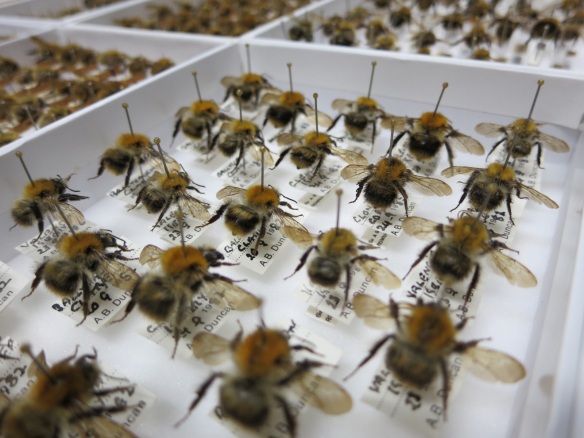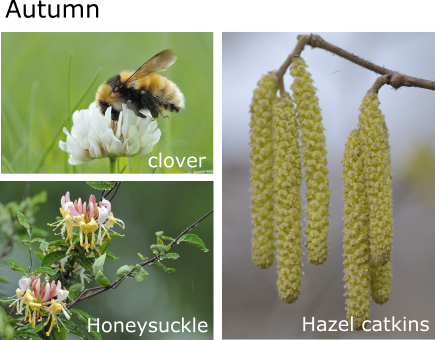Ashleigh Whiffin, Assistant Curator of Entomology, National Museums Scotland, lifts the lid on an insect collection which resides at the National Museums Collection Centre and contains over two-million insect specimens.
Of the 270 different bee species found in the UK, just 24 of them are bumblebees. Only 19 of these are found in Scotland, so you might think as there’s relatively few of them it would be easy to tell them apart, right? Well it’s not always the case…
Despite their size, bumblebees can be difficult to identify. With practise some species can be recognised in the field; but for others a voucher specimen and a microscope are required. In fact, for many species external features alone won’t do the job and the genitalia must be dissected out! The voucher specimens are pinned, dried and vital labels are added. The labels contain all the information about where and when the specimens were collected – and form concrete evidence that a particularly species occurred at a certain location, at that point in time.

Specimens of the Common Carder Bee (Bombus pascourum) in the collection, ©National Museums Scotland.
National Museums Scotland’s entomology collection resides at the National Museums Collection Centre and contains over 2 million insect specimens. Within this, we have approximately 6300 British bumblebees. The specimens are housed in trays, within drawers, which are stored in purpose-built cabinets to protect them from light and potential pests.

A drawer of Bombus pascourum specimens from the collection, ©National Museums Scotland.
The insect collection is almost 200 years in the making. Some of our oldest British Bombus specimens are from the collection of Dr R.K. Greville, accqired by the museum in 1858. The collection has developed over the years via specimen donations from local collectors, as well as active collecting by museum staff. Some of the most modern specimens are of a fairly recent newcomer to Scotland, the Tree Bumblebee (Bombus hypnorum). The latest specimen was infact collected in Edinburgh just last year, on site at NMCC! This non-native bumblebee, was discovered in Scotland back in 2013 and is continuing to spread North. It’s a distinctive species, the only one with a reddish-brown thorax, black abdomen and a white tail.
While the Tree Bumblebee is successfully spreading, populations of other bumblebees are facing decline. The Great Yellow Bumblebee, Bombus distinguendus, is one of our rarest bumblebees in the UK, which has faced a decline of 80% in the last century. Once found across the UK, it is now restricted to Northern Scotland (Caithness, The Uists & Orkney) where it is sustained by flower-rich machair. I was fortunate to see one during August 2017 on a fieldwork trip to Orkney. Unfortunately, the loss of flower-rich meadows and intensification of farming practise have played a key part in the decline of this bumblebee.

A very compliant male Great Yellow Bumblebee found at the Ring of Brodgar, Orkney (2017), ©National Museums Scotland.
On average, we host 170 visitors a year to the entomology collection at NMCC. First and foremost the collection is a research collection – a library of insects and their associated data. When this data is extracted it can provide useful information on biodiversity and species distribution. Perhaps this was in the minds of collectors such as Greville, when collecting specimens back in the 19th century – documenting insect biodiversity for future use. Perhaps not. What those collectors could certainly not forsee was the discovery of DNA and subsequent applications it has for taxonomic work on insects. DNA sequencing techniques are constantly improving and scientists are now able to extract good quality DNA samples from partial leg fragments. This is enabling the collection to be used in a completely different way and unlocking even more information that was originally thought possible by previous curators.
The collection is currently being used by London researchers from Imperial College and the Natural History Museum to study bumblebee declines. This NERC funded research, lead by Dr Richard Gill (IC) & Prof Ian Barnes (NHM), is using museum collections from across the UK to investigate how a century of land use change in the UK has affected wild bumblebee populations. Postdoctoral researcher Dr Andres Arce has been visiting our collection and imaging specimens for use in this research. As well as answering some important scientific questions, we hope the project will help increase the accessibility of our collections and further promote their use for research purposes.

Dr Andres Arce (Imperial College London) – preparing specimens for imaging/data capture, ©National Museums Scotland.
Although research is the focus, the collection has many other uses too. It often acts as an identification resource for local entomologists and students who can examine the specimens for comparison. It provides inspiration and reference material for artists and is used for also education. Sometimes specimens from the collection are taken to public events at the main museum or other NMS sites, such as the Go Wild events hosted at the Museum of Rural Life. These provide an opportunity to use the collection to educate and inspire the next generation.

Ashleigh teaching some of the younger visitors about bees, ©Ruth Armstrong Photography
If you are struggling with bumblebee identification (or any other groups of British insects) and would like to visit the collection, then get in touch. The collection is accessible by appointment only, and visits can be arranged by contacting us via the NMS website. The winter months are an ideal time to swat up on your identification skills, so you’re ready when the bees re-appear in the spring.













